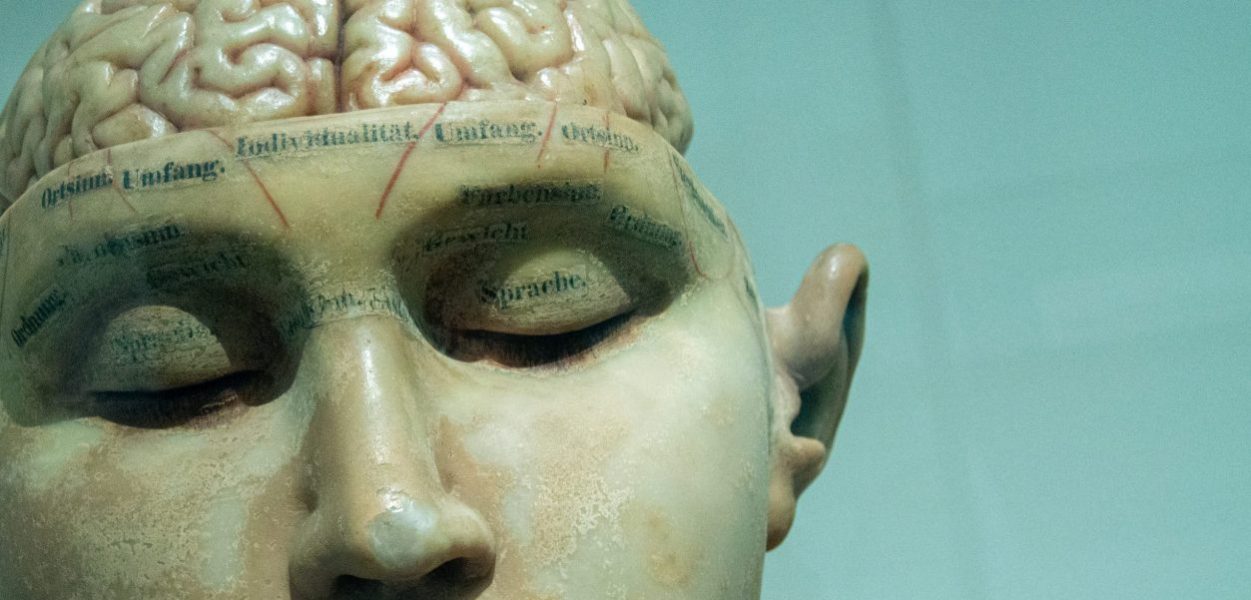Scientific Revelation through a Disproven Theory
Gregory J. Gbur—
Sometimes, the development of a revolutionary idea in science comes from first pursuing a very wrong idea. One example of this is the discovery of brain localization: the idea that different parts of the brain have different functions, which took many years, a lot of research—and a bit of luck—to confirm.
The brain may be considered to have three major sections: the cerebrum, the cerebellum, and the brainstem. The exterior of the cerebrum is called the cortex, and it contains all the nerve cells involved with higher brain activity. There are also structures that lie within the cerebrum that help coordinate between the brain and spinal components. The cerebellum, which lies underneath and behind the cerebrum, is involved in the coordination of muscle movements and specific behaviors such as posture and balance. The brainstem is responsible for automatic functions of the body such as breathing and heart function.
At the beginning of the nineteenth century, none of these functions were known, and the very idea of functional localization—that different aspects of the brain could be connected with different personality traits or actions of a living body—was not under serious consideration. The anatomy of the brain had been studied extensively, but no parts of it had been identified with specific functions.
This changed thanks to the ideas of a researcher whose work is now considered infamously wrong, the German physiologist and anatomist Franz Josef Gall (1758–1828). From a very young age, Gall became convinced that certain facial and skull features of people he knew could be correlated with aspects of their personalities and intelligence—for example, one classmate had an odd-shaped skull but was also exceedingly skilled in language. When Gall entered medical school at the University of Strasbourg, he developed these observations into a hypothesis about brain function, later known as phrenology. Gall speculated that different brain functions, behaviors, and personality traits are localized to different locations in the brain. Those areas that are overdeveloped can produce pressure on the skull, leaving a telltale bump that can be measured by trained phrenologists. An illustration of a phrenology chart is included below.

Gall’s views were met with opposition from almost all quarters. The Roman Catholic Church opposed the implication that the brain is a machine, which left no room for the soul. Scientists also opposed his results, largely due to their lack of scientific rigor—rightly so, as Gall’s particular hypothesis of brain function and its effects on the skull has been definitively proven wrong.
The idea of localization in general, however, intrigued other researchers. Among the first of these was the French physiologist Jean Pierre Flourens (1794–1867). Flourens decided to do experiments on localization, and in 1815 he produced lesions in the brains of rabbits and pigeons to see how it affected their function. His work demonstrated convincingly that different parts of the brain are broadly involved in different mechanical functions of a living body. The removal of the cerebellum, for example, caused a loss of equilibrium and motor coordination in animals.
What Flourens did not find, however, was any evidence that higher brain functions, such as memory and cognition, are localized to specific parts of the brain. Flourens acknowledged that the cerebrum, cerebellum, and medulla had separate roles but did not believe any more specific localization existed. Many scientists and religious figures alike were fine with this vague delineation, perhaps because it left open room for a “soul” lurking somewhere in the human condition.

The French physician Jean-Baptiste Bouillaud (1796–1881) pushed against this view. He earned his medical doctorate in Paris in 1823; by 1825, he had made enough clinical observations to not only conclude that brain function is localized, but that the two hemispheres of the brain do not have symmetric function. In particular, he argued that the left frontal lobe of the brain is associated with speech, and that any damage to that lobe will result in speech impairment. His arguments met with little support: by 1848, he even offered 500 Francs to anyone who could find someone who had suffered a speech impairment and had not had a corresponding left frontal lobe injury. This challenge went unanswered.
By 1852, Bouillaud’s son-in-law Ernest Auburtin (1825–1893) had publicly joined the argument on Bouillaud’s side. He was even able to present a living patient to support their claims: a man who had attempted to commit suicide, but had only succeeded in shooting away the front of his skull, exposing the frontal lobes. For the few hours he remained living, he was used as a test case for frontal lobe brain function. Incredibly, a physician used a spatula to apply gentle pressure to the patient’s frontal lobes. While pressure was present, the patient lost the ability to speak, even though he was able to communicate normally without pressure. This experiment provided direct evidence of the role of the frontal lobes in speech, but Auburtin’s work was largely neglected for years.
On April 4, 1861, however, Aubertin defended his thesis on brain localization at a meeting of the Anthropology Society in Paris. In attendance at the meeting was the French physician, anatomist, and anthropologist Paul Broca (1824–1880). By an incredible stroke of luck for science, a patient named Leborgne was admitted to the Hôpital St. Louis only seven days after the meeting to undergo surgery for gangrene. The gangrene was only the final stage of a physical and cognitive decline that had begun for Leborgne twenty years earlier with the loss of his ability to speak: since age thirty, the only word he had been able to say, with various inflections to imply meaning, was “tan.”

Broca heard of Leborgne’s case and, with Aubertin’s thesis in mind, he went to study the man who became known as “Tan.” Communicating with Leborgne was difficult, but Broca confirmed that Leborgne was able to understand what was being said to him, but unable to communicate back. Conditions in which damage to the brain results in a loss of the ability to speak or comprehend speech would become known as aphasia, from the Greek a-, “without,” and phasis, “speech.” The condition that Leborgne suffered would become known as Broca’s aphasia, and the part of the brain associated with speaking became known as Broca’s area.
Leborgne died several days after being admitted to the hospital; Broca performed an autopsy on him and confirmed, just as Bouillard had predicted, that he had a lesion of the left frontal lobe. Over the next few years, Broca found some two dozen additional cases of Broca’s aphasia, and they all had the same sort of lesion. In 1865, Broca officially presented his findings, confirming that speech, and presumably other higher functions, do possess some localization in the brain.
Broca’s research caught the attention of the German physician and anatomist Carl Wernicke (1848–1905), who began his own studies into aphasia. In 1874, he identified a new variety: the inability to understand language, even though one is still able to speak it. Through autopsies, Wernicke found that this form of aphasia was connected to damage in a different part of the brain from Broca’s area: the posterior part of the temporal lobe. This area would become known as Wernicke’s area, and the condition known as Wernicke’s aphasia.

Wernicke’s work demonstrated that the process of speech, though localized, is associated with several distinct areas and has its operations distributed throughout the brain. Broca’s area controls speaking words, while Wernicke’s area handles understanding words. So, in a sense, the people that argued in favor of functional localization and those who argued against were both partially correct: basic perception and motor activities are localized to a single brain area, but complex activities are distributed among several areas. Wernicke was then able to predict a third type of aphasia, in which the connections between Broca’s area and Wernicke’s area are damaged. Patients with such conduction aphasia can understand words but cannot repeat even simple phrases, and though they can speak fluently, their pronunciation of words is flawed. This conduction aphasia was later confirmed.
By the late 1800s, then, it was well appreciated that different functions of the brain are localized to different regions, and that complex functions may involve the coordination of multiple areas. Ironically, our modern understanding of brain behavior has its origins in one of the most infamously incorrect ideas of science: the phrenology of Franz Josef Gall.
Gregory J. Gbur is professor of physics and optical science at the University of North Carolina at Charlotte. He contributed to the book Science Blogging: The Essential Guide and writes two blogs about horror and the history of science.
Further Reading:



























